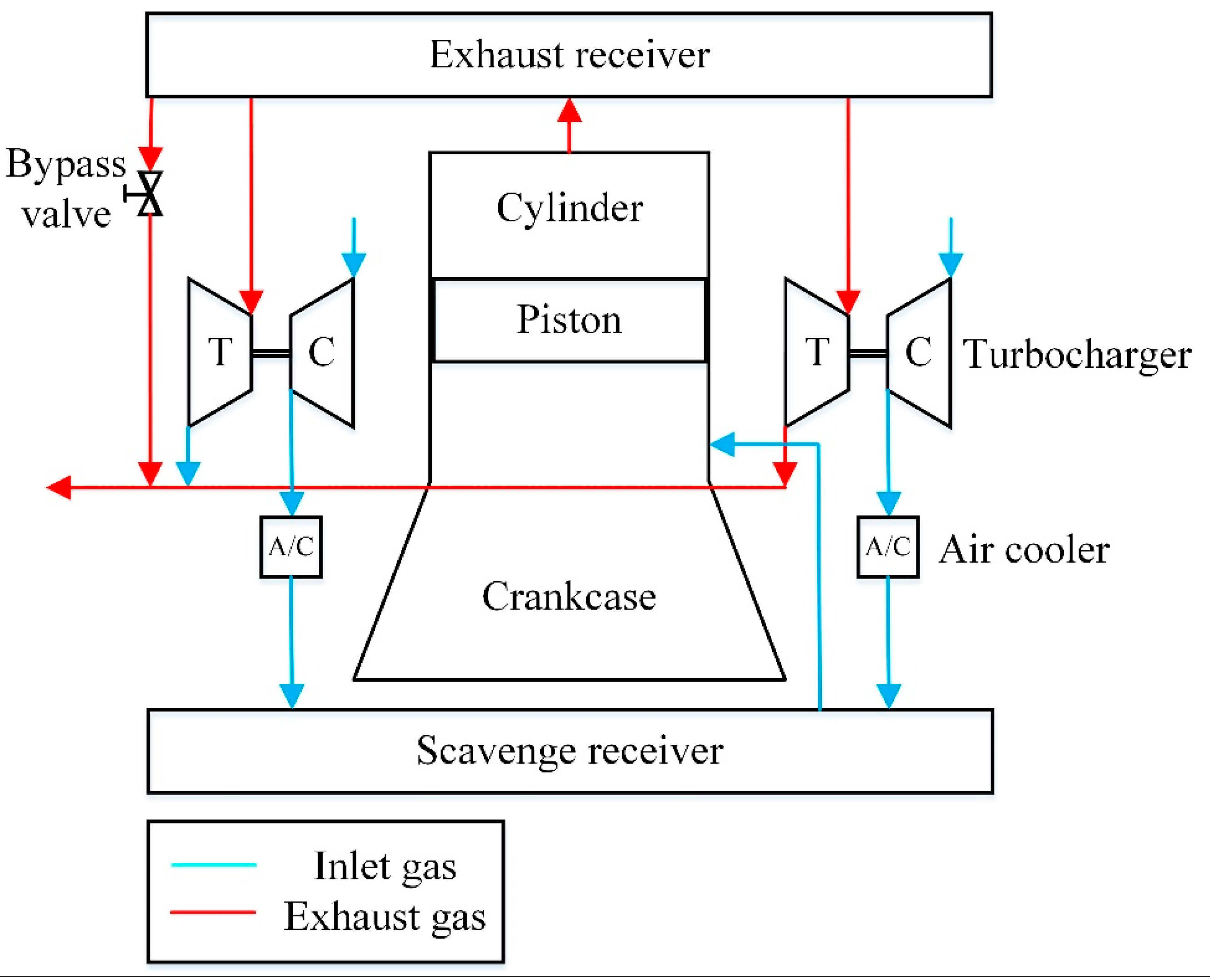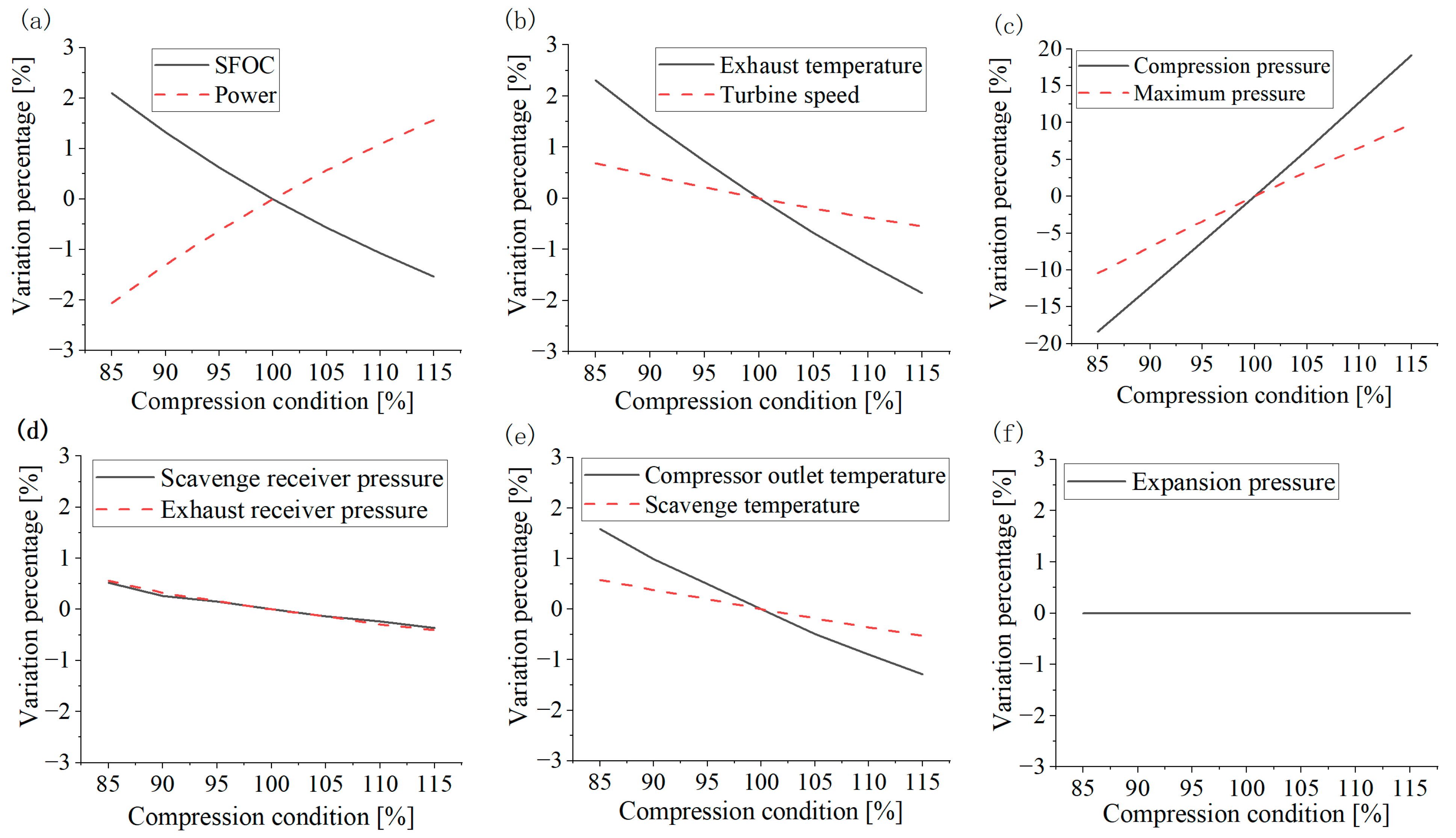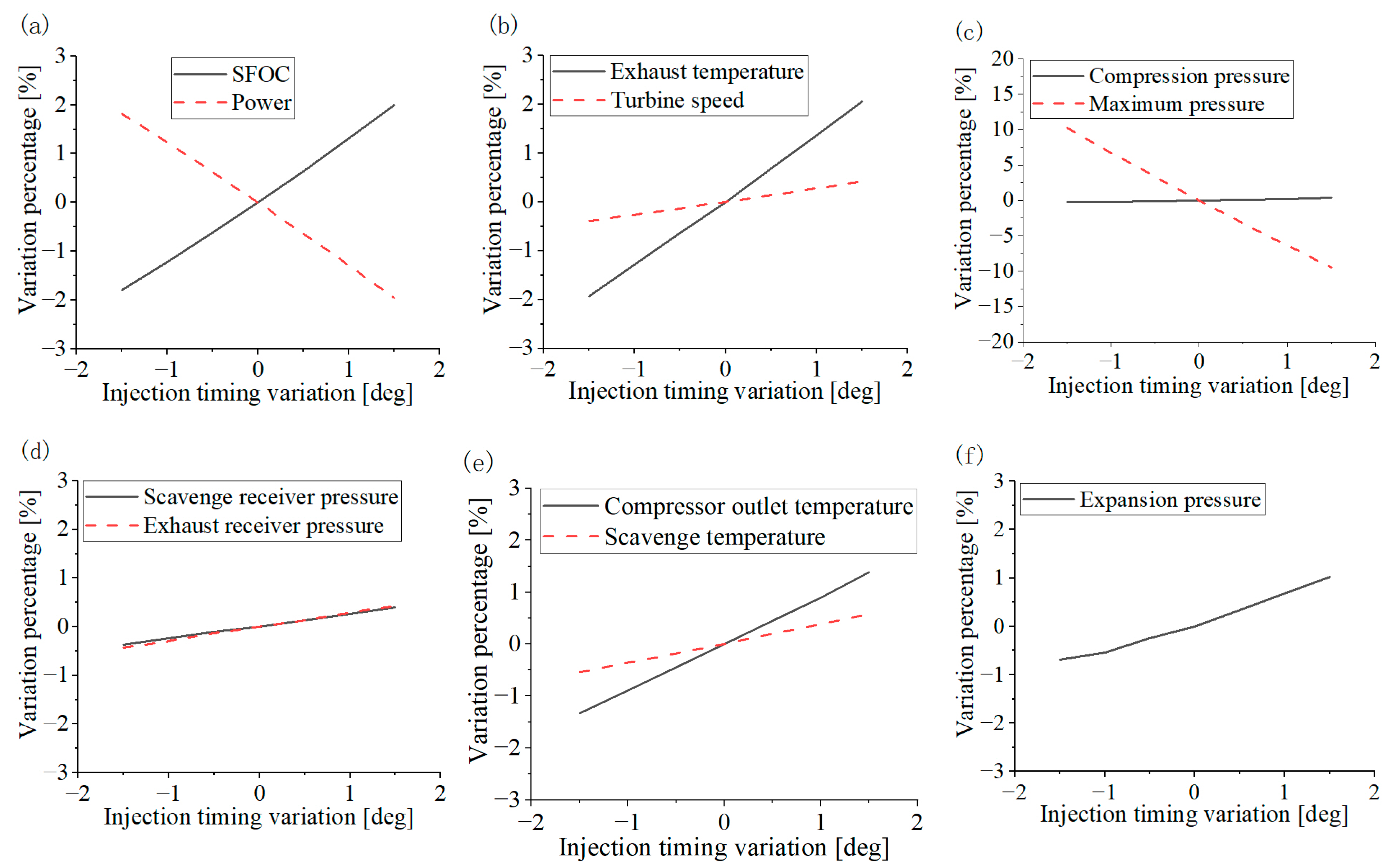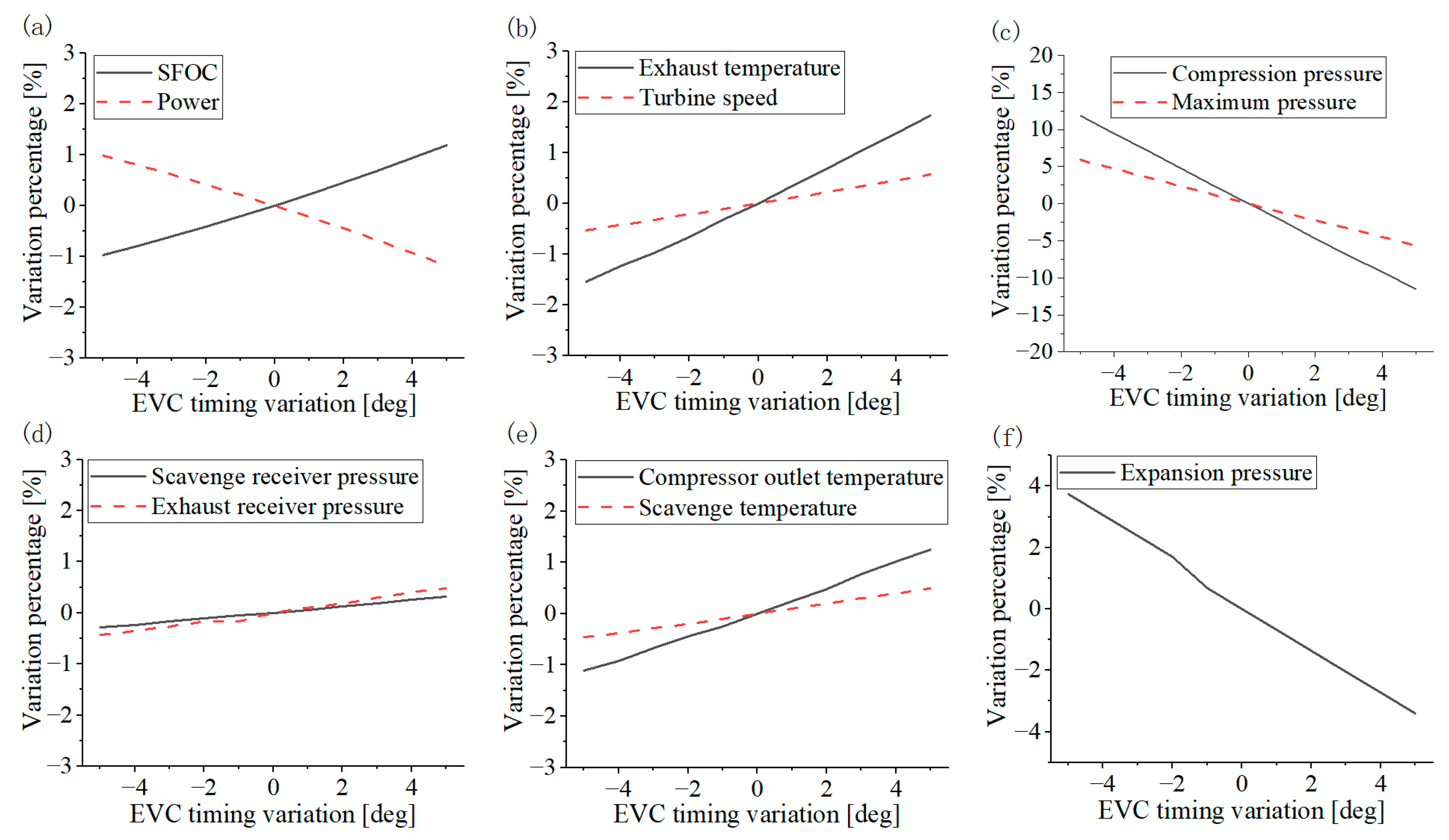Development of a Zero-Dimensional Model for a Low-Speed Two-Stroke Marine Diesel Engine with Exhaust Gas Bypass and Performance Evaluation
Abstract
:1. Introduction
2. Model Description
2.1. Basic Hypotheses
- Perfect gas behavior is assumed. This assumption is reasonable for thermal performance calculation since the errors are negligible [52].
- Two species of gas medium, air and stoichiometric combustion products, are considered [51]. All gas is considered the mixing of air and stoichiometric combustion products.
- A mean uniform temperature is assumed for the calculation of internal energy, which provides sufficient accuracy for the thermal performance simulation of the engine system [51].
2.2. Engine Cylinder Model
2.3. Sub-Models
2.3.1. Exhaust and Scavenge Receivers
2.3.2. EGB
2.3.3. Turbocharger
2.3.4. Air Cooler
2.3.5. Gas Exchange
2.3.6. Heat Release Rate
2.3.7. Heat Transfer
2.3.8. Gas Properties
3. Engine Model Setup and Validation
3.1. Model Setup
3.2. Model Validation
4. Results and Discussion
- At present, the effect of CR (compression ratio) variations was analyzed. It was studied from 85% to 115% of the normal value (32.7). A variation in CR can be caused by the replacement of the cylinder head gasket connecting the rod gasket and deposit in the cylinder.
- The influence of injection timing variations was studied by changing the timing from −1.5 degrees to 1.5 degrees of the normal value. Injection timing can be varied by an electronically controlled fuel unit.
- The bypass valve effect was discussed by changing the opening portion of the bypass valve. It was analyzed from 85% to 115% of the normal value. The variation in the opening portion may be caused by the electronically controlled EGB valve opening size and deposit in the EGB.
- The influence of EVC timing variations was considered by changing the timing from −5 degrees to 5 degrees of the normal value. The variations in EVC timing can be adjusted by the electronically controlled valve unit or the poor seal of hydraulic oil for the exhaust valve.
- The influence of EVO timing variations was investigated by varying the timing from −1 degree to 5 degrees of the normal value. The variations in EVO timing can be controlled by the electronically controlled valve unit or the poor seal of hydraulic oil for the exhaust valve.
4.1. Effect of Compression Ratio on Engine Performance
4.2. Effect of Injection Timing on Engine Performance
4.3. Effect of EGB Valve on Engine Performance
4.4. Effect of EVC Timing on Engine Performance
4.5. Effect of EVO Timing on Engine Performance
4.6. Summary of the Effects of Different Parameters
5. Conclusions
- (1)
- The model validated some engine performance parameters as well as cylinder pressure diagrams at 50%, 75%, 85%, 100%, and 110% load. The results obtained were in good agreement with the measurements. From the comparison of the calculated results with the official shop test, the model has the capability to predict the main performance parameters and the cylinder pressure with good accuracy.
- (2)
- After validation, the model was used to analyze some parameters’ effects on engine performance. Namely, the effects of compression ratio, injection timing, exhaust gas bypass valve opening portion, exhaust valve closing timing, and exhaust valve opening timing variations on engine performance were studied. Compression ratio, injection timing, and exhaust valve closing timing had strong effects on the engine’s thermal performance, while the exhaust gas bypass valve opening portion and exhaust valve opening timing had little effect on the engine’s main performance.
- (3)
- The effect level of different parameter settings on diesel engine performance was also examined. From the analysis, a high engine cylinder SFOC may be caused by different factors, such as a smaller CR, later injection timing, and later exhaust valve closing timing. The reason may be determined if the compression pressure, maximum pressure, and expansion pressure are checked further.
Author Contributions
Funding
Acknowledgments
Conflicts of Interest
Nomenclature
| Acronyms | |
| CR | Compression ratio |
| EGB | Exhaust gas bypass |
| EVC | Exhaust valve closing |
| EVO | Exhaust valve opening |
| LHV | Lower heating value |
| MDO | Marine diesel oil |
| MVEM | Mean value engine model |
| SFOC | Specific fuel oil consumption |
| TDC | Top dead center |
| Greek symbols | |
| α | Heat transfer rate (W/m2·K) |
| β | Inclination of scavenge ports (rad) |
| ∆ | Difference (-) |
| ∆θ | Combustion duration (rad) |
| ε | Air cooler efficiency (-) |
| η | Efficiency (-) |
| θ | Crank angle degree (rad) |
| σ | Exhaust valve seat cone angle (rad) |
| ω | Engine angular velocity (s−1) |
| Symbols | |
| A | Area (m2) |
| b,C0,d | Constant coefficient (-) |
| B | Width (m) |
| c | Flow coefficient (-) |
| cv | Specific heat capacity under constant volume (J/kg·K) |
| D | Disc outer diameter (m) |
| h | Specific enthalpy (J/kg) |
| H | Height (m) |
| k | Specific heat ratio (-) |
| l | Load (-) |
| m | Mass (kg) |
| M | Combustion shape factor (-) |
| Mass flow rate (kg/s) | |
| p | Pressure (Pa) |
| pi | Circumference ratio (-) |
| Q | Heat (J) |
| R | Gas constant (J/kg·K) |
| SOC | Start of combustion (rad) |
| T | Temperature (K) |
| U | Internal energy (J) |
| V | Volume (m3) |
| Speed ratio (-) | |
| w | Representative velocity |
| W | Mechanical work (J) |
| X | Mass fraction (-) |
| Subscripts | |
| a | Air |
| ac | Air cooler |
| b | Bypass valve |
| c | Compressor |
| cm | Cooling medium |
| d | Downstream |
| dc | Diffusion combustion |
| e | Exhaust valve |
| f | Fuel |
| HR | Heat release |
| in | Inlet |
| max | Maximum |
| out | Outlet |
| pc | Pre-mixed combustion |
| scp | Stoichiometric combustion products |
| sp | Scavenge ports |
| t | Turbine |
| u | Upstream |
| w | Wall |
References
- Baldi, F.; Theotokatos, G.; Andersson, K. Development of a combined mean value–zero dimensional model and application for a large marine four-stroke Diesel engine simulation. Appl. Energy 2015, 154, 402–415. [Google Scholar] [CrossRef] [Green Version]
- García-Martos, C.; Rodríguez, J.; Sánchez, M.J. Modelling and forecasting fossil fuels, CO2 and electricity prices and their volatilities. Appl. Energy 2013, 101, 363–375. [Google Scholar] [CrossRef] [Green Version]
- Zhang, C.; Chen, X. The impact of global oil price shocks on China’s bulk commodity markets and fundamental industries. Energy Policy 2014, 66, 32–41. [Google Scholar] [CrossRef] [Green Version]
- Zhang, Y.-J.; Wang, Z.-Y. Investigating the price discovery and risk transfer functions in the crude oil and gasoline futures markets: Some empirical evidence. Appl. Energy 2013, 104, 220–228. [Google Scholar] [CrossRef]
- MEPC 63/INF2. Air Pollution and Energy Efficiency-Estimated CO2 Emissions Reduction from Introduction of Mandatory Technical and Operational Energy Efficiency Measures for Ships. IMO: London, UK, 2011.
- Tsitsilonis, K.-M.; Theotokatos, G.; Patil, C.; Coraddu, A. Health assessment framework of marine engines enabled by digital twins. Int. J. Engine Res. 2023, 14680874221146835. [Google Scholar] [CrossRef]
- Stoumpos, S.; Theotokatos, G. A novel methodology for marine dual fuel engines sensors diagnostics and health management. Int. J. Engine Res. 2021, 23, 974–994. [Google Scholar] [CrossRef]
- Hautala, S.; Mikulski, M.; Söderäng, E.; Storm, X.; Niemi, S. Toward a digital twin of a mid-speed marine engine: From detailed 1D engine model to real-time implementation on a target platform. Int. J. Engine Res. 2022, 14680874221106168. [Google Scholar] [CrossRef]
- Stoumpos, S.; Theotokatos, G.; Mavrelos, C.; Boulougouris, E. Towards Marine Dual Fuel Engines Digital Twins—Integrated Modelling of Thermodynamic Processes and Control System Functions. J. Mar. Sci. Eng. 2020, 8, 200. [Google Scholar] [CrossRef] [Green Version]
- Lamaris, V.; Hountalas, D. A general purpose diagnostic technique for marine diesel engines—Application on the main propulsion and auxiliary diesel units of a marine vessel. Energy Convers. Manag. 2010, 51, 740–753. [Google Scholar] [CrossRef]
- Wang, D.; Shi, L.; Zhu, S.; Liu, B.; Qian, Y.; Deng, K. Numerical and thermodynamic study on effects of high and low pressure exhaust gas recirculation on turbocharged marine low-speed engine. Appl. Energy 2020, 261, 114346. [Google Scholar] [CrossRef]
- Baldi, F.; Johnson, H.; Gabrielii, C.; Andersson, K. Energy Analysis of Ship Energy Systems—The Case of a Chemical Tanker. Energy Procedia 2014, 61, 1732–1735. [Google Scholar] [CrossRef] [Green Version]
- Tang, Y.; Zhang, J.; Gan, H.; Jia, B.; Xia, Y. Development of a real-time two-stroke marine diesel engine model with in-cylinder pressure prediction capability. Appl. Energy 2017, 194, 55–70. [Google Scholar] [CrossRef]
- Khan, M.Y.; Giordano, M.; Gutierrez, J.; Welch, W.A.; Asa-Awuku, A.; Miller, J.W.; Cocker, I.D.R. Benefits of Two Mitigation Strategies for Container Vessels: Cleaner Engines and Cleaner Fuels. Environ. Sci. Technol. 2012, 46, 5049–5056. [Google Scholar] [CrossRef] [Green Version]
- Feng, L.; Tian, J.; Long, W.; Gong, W.; Du, B.; Li, D.; Chen, L. Decreasing NOx of a Low-Speed Two-Stroke Marine Diesel Engine by Using In-Cylinder Emission Control Measures. Energies 2016, 9, 304. [Google Scholar] [CrossRef] [Green Version]
- MEPC 62/INF7. Reduction of GHG Emissions from Ships—Marginal Abatement Costs and Cost Effectiveness of Energy-Efficiency Measures. IMO: London, UK, 2011.
- Sequino, L.; Belgiorno, G.; Di Blasio, G.; Mancaruso, E.; Beatrice, C.; Vaglieco, B.M. Assessment of the New Features of a Prototype High-Pressure “Hollow Cone Spray” Diesel Injector by Means of Engine Performance Characterization and Spray Visualization; SAE Technical Paper; SAE International: Warrendale, PA, USA, 2018. [Google Scholar]
- Svensson, E.; Tuner, M.; Verhelst, S. Influence of Injection Strategies on Engine Efficiency for a Methanol PPC Engine; SAE Technical Paper Series; SAE International: Warrendale, PA, USA, 2019. [Google Scholar]
- Sahu, T.K.; Shukla, P.C.; Belgiorno, G.; Maurya, R.K. Alcohols as alternative fuels in compression ignition engines for sustainable transportation: A review. Energy Sources Part A Recovery Util. Environ. Effects 2022, 44, 8736–8759. [Google Scholar] [CrossRef]
- Konrad, J.; Lauer, T.; Moser, M.; Lockner, E.; Zhu, J. Engine Efficiency Optimization under Consideration of NOX- and Knock-Limits for Medium Speed Dual Fuel Engines in Cylinder Cut-Out Operation; SAE Technical Paper; SAE International: Warrendale, PA, USA, 2018. [Google Scholar]
- Discenzo, F.M.; Nickerson, W.; Mitchell, C.E.; Keller, K.J. Open Systems Architecture Enables Health Management for Next Generation System Monitoring and Maintenance; Development Program White Paper; United Nations Development Program: New York, NY, USA, 2001. [Google Scholar]
- Ansari, E.; Shahbakhti, M.; Naber, J. Optimization of performance and operational cost for a dual mode diesel-natural gas RCCI and diesel combustion engine. Appl. Energy 2018, 231, 549–561. [Google Scholar] [CrossRef]
- Pham, X.; Noor, M.; Hoang, A. Comparative Analysis on Performance and Emission Characteristic of Diesel Engine Fueled with Heated Coconut Oil and Diesel Fuel. Int. J. Automot. Mech. Eng. 2018, 15, 5110–5125. [Google Scholar] [CrossRef]
- Gonca, G.; Hocaoglu, M.F. Performance Analysis and Simulation of a Diesel-Miller Cycle (DiMC) Engine. Arab. J. Sci. Eng. 2019, 44, 5811–5824. [Google Scholar] [CrossRef]
- Solmaz, H.; Ardebili, S.M.S.; Aksoy, F.; Calam, A.; Yılmaz, E.; Arslan, M. Optimization of the operating conditions of a beta-type rhombic drive stirling engine by using response surface method. Energy 2020, 198, 117377. [Google Scholar] [CrossRef]
- Kumar, S.; Chauhan, M.K. Numerical modeling of compression ignition engine: A review. Renew. Sustain. Energy Rev. 2013, 19, 517–530. [Google Scholar] [CrossRef]
- Sui, C.; Song, E.; Stapersma, D.; Ding, Y. Mean value modelling of diesel engine combustion based on parameterized finite stage cylinder process. Ocean Eng. 2017, 136, 218–232. [Google Scholar] [CrossRef] [Green Version]
- Theotokatos, G.; Guan, C.; Chen, H.; Lazakis, I. Development of an extended mean value engine model for predicting the marine two-stroke engine operation at varying settings. Energy 2018, 143, 533–545. [Google Scholar] [CrossRef] [Green Version]
- Guan, C.; Theotokatos, G.; Zhou, P.; Chen, H. Computational investigation of a large containership propulsion engine operation at slow steaming conditions. Appl. Energy. 2014, 130, 370–383. [Google Scholar] [CrossRef] [Green Version]
- Theotokatos, G.; Tzelepis, V. A computational study on the performance and emission parameters mapping of a ship propulsion system. Proc. Inst. Mech. Eng. Part M J. Eng. Marit. Environ. 2015, 229, 58–76. [Google Scholar] [CrossRef] [Green Version]
- Zhu, S.; Gu, Y.; Yuan, H.; Ma, Z.; Deng, K. Thermodynamic analysis of the turbocharged marine two-stroke engine cycle with different scavenging air control technologies. Energy 2020, 191, 116533. [Google Scholar] [CrossRef]
- Galindo, J.; Serrano, J.; Vera, F.; Cervelló, C.; Lejeune, M. Relevance of valve overlap for meeting Euro 5 soot emissions requirements during load transient process in heavy duty diesel engines. Int. J. Veh. Design. 2006, 41, 343–367. [Google Scholar] [CrossRef]
- Vera-García, F.; Pagán Rubio, J.A.; Hernández Grau, J.; Albaladejo Hernández, D. Improvements of a Failure Database for Marine Diesel Engines Using the RCM and Simulations. Energies 2020, 13, 104. [Google Scholar] [CrossRef] [Green Version]
- Rubio, J.A.P.; Vera-García, F.; Grau, J.H.; Cámara, J.M.; Hernandez, D.A. Marine diesel engine failure simulator based on thermodynamic model. Appl. Therm. Eng. 2018, 144, 982–995. [Google Scholar] [CrossRef]
- Badawy, T.; Henein, N. Three-Dimensional Computational Fluid Dynamics Modeling and Validation of Ion Current Sensor in a Gen-Set Diesel Engine Using Chemical Kinetic Mechanism. J. Eng. Gas Turbines Power 2017, 139, 102810. [Google Scholar] [CrossRef]
- Zhou, C.; Jiang, X.; Wang, X. Dynamic Balance Analysis of Crankshaft Based on Three-Dimensional Model. In International Workshop of Advanced Manufacturing and Automation; Springer: Berlin/Heidelberg, Germany, 2018; pp. 592–600. [Google Scholar]
- Rakopoulos, C.; Kosmadakis, G.; Pariotis, E. Investigation of piston bowl geometry and speed effects in a motored HSDI diesel engine using a CFD against a quasi-dimensional model. Energy Convers. Manag. 2010, 51, 470–484. [Google Scholar] [CrossRef]
- Wu, S.; Zhou, D.; Yang, W. Implementation of an efficient method of moments for treatment of soot formation and oxidation processes in three-dimensional engine simulations. Appl. Energy 2019, 254, 113661. [Google Scholar] [CrossRef]
- Jafarmadar, S. Exergy analysis of hydrogen/diesel combustion in a dual fuel engine using three-dimensional model. Int. J. Hydrogen Energy 2014, 39, 9505–9514. [Google Scholar] [CrossRef]
- Jafarmadar, S.; Nemati, P. Exergy analysis of diesel/biodiesel combustion in a homogenous charge compression ignition (HCCI) engine using three-dimensional model. Renew. Energy 2016, 99, 514–523. [Google Scholar] [CrossRef]
- Yıldız, M.; Çeper, B.A. Zero-dimensional single zone engine modeling of an SI engine fuelled with methane and methane-hydrogen blend using single and double Wiebe Function: A comparative study. Int. J. Hydrogen Energy 2017, 42, 25756–25765. [Google Scholar] [CrossRef]
- Hairuddin, A.A.; Yusaf, T.; Wandel, A.P. Single-zone zero-dimensional model study for diesel-fuelled homogeneous charge compression ignition (HCCI) engines using Cantera. Int. J. Automot. Mech. Eng. 2016, 13, 3309–3328. [Google Scholar] [CrossRef]
- Catania, A.E.; Finesso, R.; Spessa, E. Predictive zero-dimensional combustion model for DI diesel engine feed-forward control. Energy Convers. Manag. 2011, 52, 3159–3175. [Google Scholar] [CrossRef]
- Kim, Y.; Kim, M.; Kim, J.; Song, H.H.; Park, Y.; Han, D. Predicting the Influences of Intake Port Geometry on the Tumble Generation and Turbulence Characteristics by Zero-Dimensional Spark Ignition Engine Model; SAE Technical Paper; SAE International: Warrendale, PA, USA, 2018. [Google Scholar]
- Guan, C.; Theotokatos, G.; Chen, H. Analysis of Two Stroke Marine Diesel Engine Operation Including Turbocharger Cut-Out by Using a Zero-Dimensional Model. Energies 2015, 8, 5738–5764. [Google Scholar] [CrossRef] [Green Version]
- Finesso, R.; Spessa, E. A real time zero-dimensional diagnostic model for the calculation of in-cylinder temperatures, HRR and nitrogen oxides in diesel engines. Energy Convers. Manag. 2014, 79, 498–510. [Google Scholar] [CrossRef]
- Aghdam, E.A.; Kabir, M. Validation of a blowby model using experimental results in motoring condition with the change of compression ratio and engine speed. Exp. Therm. Fluid Sci. 2010, 34, 197–209. [Google Scholar] [CrossRef]
- Larsen, U.; Pierobon, L.; Baldi, F.; Haglind, F.; Ivarsson, A. Development of a model for the prediction of the fuel consumption and nitrogen oxides emission trade-off for large ships. Energy 2015, 80, 545–555. [Google Scholar] [CrossRef] [Green Version]
- Payri, F.; Olmeda, P.; Martín, J.; García, A. A complete 0D thermodynamic predictive model for direct injection diesel engines. Appl. Energy 2011, 88, 4632–4641. [Google Scholar] [CrossRef]
- Hountalas, D.T. Prediction of marine diesel engine performance under fault conditions. Appl. Therm. Eng. 2000, 20, 1753–1783. [Google Scholar] [CrossRef]
- Heywood, J.B. Combustion Engine Fundamentals; McGraw-Hill: New York, NY, USA, 1988. [Google Scholar]
- Lapuerta, M.; Ballesteros, R.; Agudelo, J.R. Effect of the gas state equation on the thermodynamic diagnostic of diesel combustion. Appl. Therm. Eng. 2006, 26, 1492–1499. [Google Scholar] [CrossRef]
- Bejan, A.; Kraus, A.D. Heat Transfer Handbook; John Wiley & Sons: Hoboken, NJ, USA, 2003. [Google Scholar]
- Yum, K.K.; Taskar, B.; Pedersen, E.; Steen, S. Simulation of a two-stroke diesel engine for propulsion in waves. Int. J. Nav. Archit. Ocean. Eng. 2017, 9, 351–372. [Google Scholar] [CrossRef] [Green Version]
- Watson, N.; Janota, M. Turbocharging the Internal Combustion Engine; Macmillan International Higher Education: London, UK, 1982. [Google Scholar]
- Scappin, F.; Stefansson, S.H.; Haglind, F.; Andreasen, A.; Larsen, U. Validation of a zero-dimensional model for prediction of NOx and engine performance for electronically controlled marine two-stroke diesel engines. Appl. Therm. Eng. 2012, 37, 344–352. [Google Scholar] [CrossRef]
- Miyamoto, N.; Chikahisa, T.; Murayama, T.; Sawyer, R. Description and analysis of diesel engine rate of combustion and performance using Wiebe’s functions. SAE Trans. 1985, 94, 622–633. [Google Scholar]
- Woschni, G. A Universally Applicable Equation for the Instantaneous Heat Transfer Coefficient in the Internal Combustion Engine; SAE Technical Paper; SAE International: Warrendale, PA, USA, 1967. [Google Scholar]
- Lapuerta, M.; Armas, O.; Hernández, J. Diagnosis of DI Diesel combustion from in-cylinder pressure signal by estimation of mean thermodynamic properties of the gas. Appl. Therm. Eng. 1999, 19, 513–529. [Google Scholar] [CrossRef]
- Wang, H.; Zhang, J.; Zeng, H. Modeling and Simulation of Working Process of Large Low Speed Diesel Engine. J. Dalian Marit. Univ. 2006, 32, 1–4. [Google Scholar]








| Parameters | Load (%) | ||||
|---|---|---|---|---|---|
| 50 | 75 | 85 | 100 | 110 | |
| 0.88 | 0.92 | 0.83 | 0.75 | 0.78 | |
| 18.0 | 22.0 | 20.0 | 23.0 | 25 | |
| −0.1 | −0.1 | 0.3 | 0.3 | 0.5 | |
| Parameters | Values |
|---|---|
| Rated power | 21,000 kW |
| Rated speed | 58 rpm |
| Number of cylinders | 7 |
| Cylinder bore | 900 mm |
| Stroke | 3720 mm |
| Connecting rod length | 3720 mm |
| Displacement volume | 1.87 m3 |
| Compression ratio | 32.7:1 |
| Turbocharger type | TCA66-21*2 |
| Bypass valve diameter | 61 mm |
| Number of air coolers | 2 |
| LHV | 4.292 × 107 J/kg |
| Fire order | 1-7-2-5-4-3-6 |
| Parameters | CR Increase | Injection Timing Increase | Bypass Valve Increase | EVC Timing Increase | EVO Timing Increase |
|---|---|---|---|---|---|
| SFOC | − − | ++ | ο | ++ | − |
| Power | ++ | − − | ο | − − | + |
| Exhaust temperature | − − | ++ | + | ++ | ο |
| Turbine speed | − | + | − − | + | ο |
| Compression pressure | ++ | − − | ο | − − | ο |
| Maximum pressure | ++ | ο | ο | − − | ο |
| Scavenge receiver pressure | − | + | ο | + | ο |
| Exhaust receiver pressure | − | + | ο | + | ο |
| Compressor outlet temperature | − − | ++ | − | ++ | ο |
| Scavenge temperature | − | + | − | + | ο |
| Expansion pressure | ο | + | ο | − − | ο |
Disclaimer/Publisher’s Note: The statements, opinions and data contained in all publications are solely those of the individual author(s) and contributor(s) and not of MDPI and/or the editor(s). MDPI and/or the editor(s) disclaim responsibility for any injury to people or property resulting from any ideas, methods, instructions or products referred to in the content. |
© 2023 by the authors. Licensee MDPI, Basel, Switzerland. This article is an open access article distributed under the terms and conditions of the Creative Commons Attribution (CC BY) license (https://creativecommons.org/licenses/by/4.0/).
Share and Cite
Zhang, D.; Shen, Z.; Xu, N.; Zhu, T.; Chang, L.; Song, H. Development of a Zero-Dimensional Model for a Low-Speed Two-Stroke Marine Diesel Engine with Exhaust Gas Bypass and Performance Evaluation. Processes 2023, 11, 936. https://doi.org/10.3390/pr11030936
Zhang D, Shen Z, Xu N, Zhu T, Chang L, Song H. Development of a Zero-Dimensional Model for a Low-Speed Two-Stroke Marine Diesel Engine with Exhaust Gas Bypass and Performance Evaluation. Processes. 2023; 11(3):936. https://doi.org/10.3390/pr11030936
Chicago/Turabian StyleZhang, Defu, Zhenyu Shen, Nan Xu, Tingting Zhu, Lei Chang, and Hui Song. 2023. "Development of a Zero-Dimensional Model for a Low-Speed Two-Stroke Marine Diesel Engine with Exhaust Gas Bypass and Performance Evaluation" Processes 11, no. 3: 936. https://doi.org/10.3390/pr11030936
APA StyleZhang, D., Shen, Z., Xu, N., Zhu, T., Chang, L., & Song, H. (2023). Development of a Zero-Dimensional Model for a Low-Speed Two-Stroke Marine Diesel Engine with Exhaust Gas Bypass and Performance Evaluation. Processes, 11(3), 936. https://doi.org/10.3390/pr11030936








